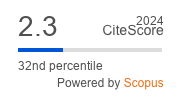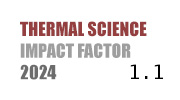ABSTRACT
Solar thermal collectors are increasingly popular for harnessing renewable energy to meet global energy demands sustainably. These systems convert solar radiation into thermal energy for residential, commercial, and industrial use. Enhancing their efficiency, nanofluids-base fluids with suspended nanoparticles have been widely studied. This experimental research explores a flat-plate solar collector integrating zigzag rectangular angled strips within the absorber tube and using nanofluids such as MgO/DIW, ZnO/DIW, and Al2O3/DIW at 1.0 vol.% concentration. The study examines the thermal performance at 45° angled strips with pitch ratios (Y) of 2.0, 3.0, and 4.0 under identical conditions. Results show that for a pitch ratio of 2.0, MgO/DIW, ZnO/DIW, and Al2O3/DIW enhance heat transfer by 30%, 28%, and 22%, respectively, at higher Reynolds numbers compared to DIW. The Nusselt number increases by 45%, 42%, and 40%, with MgO/DIW consistently delivering the highest heat transfer enhancement. Thermal efficiency reaches approximately 85% for MgO/DIW nanofluids, outperforming DIW at lower pitch ratios. However, the friction factor rises by 15% for ZnO/DIW at lower Reynolds numbers, and pumping power increases by 10% for ZnO/DIW in zigzag strip tubes compared to plain tubes. These findings confirm that combining high thermal conductivity nanofluids and optimized zigzag strip designs significantly boosts the thermal efficiency of solar collectors. This research highlights the potential of nanofluid integration and geometric modifications for advancing solar energy technologies.
KEYWORDS
PAPER SUBMITTED: 2024-07-09
PAPER REVISED: 2024-10-28
PAPER ACCEPTED: 2024-12-04
PUBLISHED ONLINE: 2025-01-09
THERMAL SCIENCE YEAR
2025, VOLUME
29, ISSUE
Issue 1, PAGES [751 - 765]
- Lee, C.-Y., et al., Sun Tracking Systems: A Review, Sensors, 9 (2009), 5, pp. 3875-3890
- Shin, D., et al., Investigation of Nanofluids for Solar Thermal Storage Applications, Proceedings, 3rd International Conference on Energy Sustainability collocated with the Heat Transfer and InterPACK09 Conferences, San Francisco, Cal., USA, 2009, no.19-23, pp. 819-822
- Javadipour, S., et al., Characterization of Al12Mg17 Nanofluid by Dynamic Light Scattering and Beam Displacement Methods, Cornell University, On-Line first, doi.org/10.48550/arXiv.2306.13766, 2023
- Yang, M., et al., Thermal Stability and Performance Testing of Oil-Based CuO Nanofluids for Solar Thermal Applications, Multidisciplinary Digital Publishing Institute, 13 (2020), 4, pp. 876-876
- Hai, T., et al., Energy and Cost Management of Different Mixing Ratios and Morphologies on Mono and Hybrid Nanofluids in Collector Technologies, Engineering Applications of Computational Fluid Mechanics Taylor & Francis, 17 (2023), 1, 2164620
- Hawwash, A. A., et al., Thermal Analysis of Flat Plate Solar Collector Using Different Nanofluids and Nanoparticles Percentages, Institute of Electrical and Electronics Engineers, 9 (2021), Feb., pp. 52053-52066
- Mostafizur, R. M., et al., Thermodynamic Analysis of a Flat Plate Solar Collector with Different Hybrid Nanofluids as Working Medium-A Thermal Modelling Approach, Multidisciplinary Digital Publishing Institute, 13 (2023), 8, pp. 1320-1320
- Sheikholeslami, M., et al., Recent Progress on Flat Plate Solar Collectors and Photovoltaic Systems in the Presence of Nanofluid: A Review, Journal of Cleaner Production, 293 (2021), 126119
- Singh, A. K., et al., Energy and Exergy Analysis of a Rectangular-Shaped Mini-Channel Flat-Plate Solar Collector Using Tio2-Water and Cu-Water Nanofluids, Science and Engineering Research Support Society, 44 (2023), 2, pp. 806-826
- Saffarian, M. R., et al., Heat Transfer Enhancement in a Flat Plate Solar Collector with Different Flow Path Shapes Using Nanofluid, Renewable Energy, 146 (2019), Feb., pp. 2316-2329
- Peng, Y., et al., Investigation of Energy Performance in a U-Shaped Evacuated Solar Tube Collector Using Oxide Added Nanoparticles Through the Emitter, Absorber and Transmittal Environments via Discrete Ordinates Radiation Method, J. Therm. Anal. Calorim., 139 (2019), Aug., pp. 2623-2631
- Arora, S., et al., Energy and Exergy Analysis of Marquise Shaped Channel Flat Plate Solar Collector Using Al2O3-Water Nanofluid and Water, Journals of Solar Engineering, 141 (2019), 041008
- Sheikholeslami, M., et al., Analyzing Entropy and Thermal Behavior of Nanomaterial Through Solar Collector Involving New Tapes, International Communications in Heat and Mass Transfer, 123 (2021) 105190
- Panda, R. C., et al., Nanofluid Based Pipe Flow Analysis in Absorber Pipe of Flat Plate Solar Collector: Effects of Inclination and Porosity, American Scientific Publishers, 12 (2023), 2, pp. 458-464
- Bezaatpour, M., et al., Design and Evaluation of Flat Plate Solar Collector Equipped with Nanofluid, Rotary Tube, and Magnetic Field Inducer in a Cold Region, Renewable Energy, 170 (2021), June, pp. 574-586
- Yan, S.-R., et al., Effect of U-Shaped Absorber Tube on Thermal-Hydraulic Performance and Efficiency of Two-Fluid Parabolic Solar Collector Containing Two-Phase Hybrid Non-Newtonian Nanofluids, International Journal of Mechanical Sciences, 185 (2020), 105832
- Suthahar, S. T., et al., .Experimental Investigation on Solar Flat Plate Collector Using Alumina Nanofluid with Tube Inserts, Maney Publishing, 37 (2020), 3, pp. 179-189
- Hussein, O. A., et al., Thermal Performance Enhancement of a Flat Plate Solar Collector Using Hybrid Nanofluid, Solar Energy, 204 (2020), July, pp. 208-222
- Eltaweel, M., et al., Indirect Thermosiphon Flat‐Plate Solar Collector Performance Based on Twisted Tube Design Heat Exchanger Filled with Nanofluid, International Journal of Energy Research, 44 (2020) 6, pp. 4269-4278
- Allouhi, A., et al., Heat Pipe Flat Plate Solar Collectors Operating with Nanofluids, Solar Energy Materials and Solar Cells, 219 (2021), 110798
- Munuswamy, D. B., et al., Experimental Investigation on Lowering the Environmental Hazards and Improving the Performance Patterns of Solar Flat Plate Collectors by Employing the Internal Longitudinal Fins and Nano Additives, Environmental Science and Pollution Research, 27 (2020), Aug., pp. 45390-45404
- Holman, J. P., Experimental Methods for Engineers, 7th ed., McGraw-Hill, New York, USA, 2001
- Shajahan, M. I., et al., Heat Transfer Investigations of In-Line Conical Strip Inserts Using MWCNT/Water Nanofluid Under Laminar Flow Condition, International Journal of Thermal Sciences, 183 (2023), 107844
- Mwesigye, A., et al., Heat Transfer and Thermodynamic Performance of a Parabolic Trough Receiver with Centrally Placed Perforated Plate Inserts, Appl. Energy, 136 (2014), Dec., pp. 989-1003
- Chaurasia, S. R., et al., Numerical and Experimental Thermal Performance with Entropy Generation Analysis on Tube with Helical Screw Tape Inserts at Number of Strips in Turbulent Flow, Proc. Inst. Mech. Eng. Part C J. Mech. Eng. Sci., 235 (2021), 6, pp. 1057-1070
- Chakraborty, O., et al., Impact of Helical Coil Insert in the Absorber Tube of Parabolic Trough Collector, Smart Innov. Syst. Technol, 206 (2021), Mar., pp. 177-187
- Chakraborty, O., et al., Heat Transfer Enhancement Analysis of Parabolic Trough Collector with Straight and Helical Absorber Tube, Therm. Sci. Eng. Prog, 20 (2020), 100718
- Kalogirou, S. A., Solar Energy Engineering: Processes and Systems, 2nd ed., Elsevier Inc., Amsterdam, The Netherlands, 2009
- Mebarek-Oudina, F., et al., Entropy and Convection Effect on Magnetized Hybrid Nano-Liquid Flow Inside a Trapezoidal Cavity with Zigzagged Wall, International Communications in Heat and Mass Transfer, 125 (2021), 105279
- Bisheh, M. M., et al., Impact of Hybrid Nanofluids (Ag-TiO2/H2O) on Improving the Performance of a Heat Exchanger with Turbulent Induction Elements, Engineering Reports, 4 (2022), 12502
- Louis, S. P., et al., Application of Nanofluids in Improving the Performance of Double-Pipe Heat Exchangers-A Critical Review, Materials, 15 (2022), 6879
- Abdullah, M., et al., Impact of Coil Pitch on Heat Transfer Enhancement of a Turbulent Flow of α-Al2O3/DW Nanofluid Through Helical Coils, Thermal Science, 27 (2023), 6B, pp. 5005-5014
- Kwak, D.-B., et al., Numerical Investigation of Nanoparticle Deposition Location and Pattern on a Sharp-Bent Tube Wall, International Journal of Heat and Mass Transfer, 164 (2021), 120534
- Huang, P., et al., Energy Dissipation Mechanism of a Centrifugal Pump with Entropy Generation Theory, AIP Advances, 11 (2021), 045208

